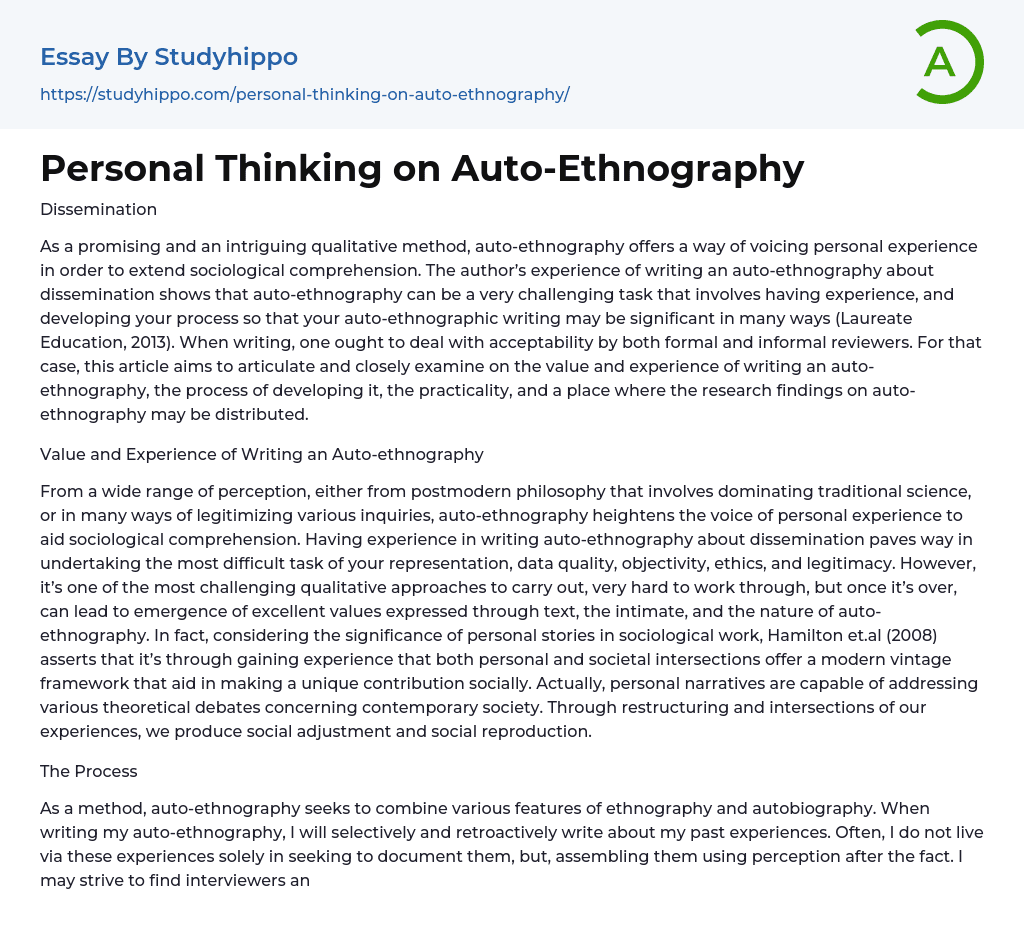Dissemination
As an exciting and thought-provoking qualitative method, auto-ethnography provides an opportunity to express personal experiences and deepen sociological understanding.
The author's experience of writing an auto-ethnography about dissemination demonstrates that auto-ethnography can be a difficult task that requires experience and the development of a process to ensure the significance of the writing (Laureate Education, 2013). When writing, an individual must consider the acceptability of their work by both formal and informal reviewers. This article aims to explore and analyze the value and experience of writing an auto-ethnography, the process of its development, the practicality of it, and the platforms for distributing research findings on auto-ethnography.
Value and Experience of Writing an Auto-ethnography
From various perspectives, whether it be postmodern philosophy challenging traditional scientific methods or legitimizing different types of inquiry, auto-ethnography amplifies personal experienc
...es to enhance sociological understanding.
Writing auto-ethnography about dissemination is a difficult task that requires consideration of various factors such as data quality, objectivity, ethics, and legitimacy. Despite its challenges, auto-ethnography can lead to the emergence of valuable insights expressed through text, personal experiences, and the nature of the research approach. Personal stories hold great significance in sociological work, as they offer a modern vintage framework that contributes to unique social insights. Personal narratives can address theoretical debates related to contemporary society (Hamilton et.al, 2008).
Through the restructuring and intersection of our experiences, we generate social adjustment and social reproduction.
The Process
Auto-ethnography is a method that combines ethnography and autobiography. When I write my auto-ethnography, I selectively and retrospectively focus on my past experiences. Instead of simply living through these experiences, I assemble them using perception
after the fact. I may seek out interviews and use various tools such as recordings and photographs to aid in recalling information. Like many auto-ethnographers, I write about epiphanies in order to remember moments that have had a significant impact on my existential crises and analyze lived familiarity. I also explore events that highlight the distinctiveness of life.
Epiphanies are personal experiences that are considered transformative and distinct from others. They reveal ways of navigating complex situations and leave lasting impressions of memories, emotions, and images related to a specific event (Atkinson ; Robert, 2007). As an auto-ethnographer, it is important for me to utilize methodological tools and research literature to analyze my own experiences and understand how others may have had similar epiphanies. Additionally, incorporating personal experiences is essential in illustrating cultural facets that are shared by both insiders and outsiders.
Efficacy of Auto-ethnographic Writing
When writing auto-ethnographies, researchers aim to communicate the rich and expressive details of their interactive and unique involvements that can bring about social change. This involves identifying patterns from field notes, cultural experiences, and interviews, and vividly describing these patterns through storytelling. Some may also incorporate visual elements or alter their authorial voice (Knowles ; Gilbourne, 2010).
Auto-ethnography not only provides an explanation of individual experiences, but also makes them more meaningful and engaging. This is particularly true through the accessibility of texts, which allows for inclusive audiences that are often disregarded in traditional research. As a result, auto-ethnography holds promise for both individual and communal transformation.
Disseminating Auto-ethnographic Research Findings
By expressing my stories through writing, I am able to provide an outward explanation that allows readers and participants to understand experiences on
a practical level. This approach also allows researchers and authors from different contexts to identify similar societal issues, such as the isolation felt by individuals with illnesses, healthcare conspiracies, and harmful customs related to sexuality. Writing this auto-ethnography is also important in a therapeutic context, as it helps us make sense of our experiences and release burdens. This process also prompts us to ask important questions about our ideal social selves, requiring conventional, projective, and authoritative narratives in order to endure (Atkinson ; Robert, 2007).
Auto-ethnographers, as witnesses, collaborate with others to validate the meaning of their pain. This collaboration also enables readers to diversify their perspectives and empowers them to cope with or desire change in their own circumstances.
References
- Atkinson, Robert (2007). The life story interview as a bridge in narrative inquiry. In D. Jean Clandinin (Ed.), Handbook of narrative inquiry (pp.224-245). Thousand Oaks, CA: Sage.
- Hamilton, M. L., Smith, L., ; Worthington, K. (2008).
Fitting the methodology with the research: An exploration of narrative, self-study, and auto-ethnography. Studying Teacher Education, 4(1), 17-28.
The information on dissemination can be found in a video file titled "Dissemination." It was produced by Laureate Education in 2013 and can be accessed at https://class.waldenu.edu. Furthermore, the topic is covered in The Sport Psychologist, Volume 24 Issue 4.
- Cultural Assimilation essays
- Demography essays
- Ethnographic essays
- Population essays
- Population Growth essays
- Aesthetics essays
- Art History essays
- Artist essays
- ballet essays
- Body Art essays
- Color essays
- Concert Review essays
- Creativity essays
- Cultural Anthropology essays
- Ethnography essays
- Harlem Renaissance essays
- Heritage essays
- Modernism essays
- Mona Lisa essays
- Pastoral essays
- Postmodernism essays
- Realism essays
- Symbolism essays
- Theatre essays
- Visual Arts essays
- Voice essays
- Work of art essays




